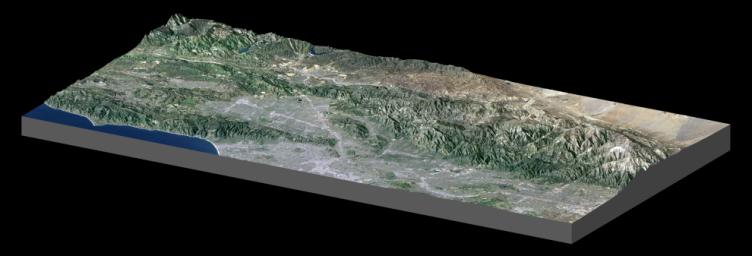The Shuttle Radar Topography Mission (SRTM) has produced the first high-resolution, near-global elevation dataset of Earth. In recognition of this achievement, and as an illustration of the data, the United States Library of Congress now displays a "solid terrain model" of Los Angeles and adjacent mountainous terrain. The model was created by carving a high-density foam block using computer-guided drills that referenced the SRTM dataset. The block was then covered with a Landsat satellite image using computer-guided paint guns that referenced both the Landsat image and the SRTM dataset. The view shown here mimics the actual model on display at the Library of Congress and was generated from the same satellite image and elevation data sets.
The model shows the Pacific Ocean and Santa Monica Mountains along the Malibu Coast (lower left), San Fernando Valley (left center), downtown Los Angeles (bottom center), San Gabriel and Pomona Valleys (lower right), San Gabriel Mountains (right center to far right), and part of the Mojave Desert (upper right). Colors are enhanced true color with added topographic shading, and elevation differences are exaggerated 1.5 times. The view is toward the north-northwest.
The Los Angeles region was chosen for the Library of Congress model because it illustrates so many ways that topography affects the daily lives of people. The region consists of a coastal plain, inland valleys, mountains up to 3068 meters (10,064 feet), and a desert interior. Topography blocks the landward influence of marine airmasses here such that summer temperatures often differ by 40 degrees Fahrenheit (22 C) across this region at a given moment even at similar elevations. Temperatures also typically cool with rising elevation, and winter storms drop most of their moisture in the mountains, leaving little rainfall for areas further inland, thus creating the deserts.
Topography also controls the land use pattern. The mountains are mostly very rugged, which greatly limits urban expansion. Similarly, major transportation routes are limited to a few mountain passes. Water supply to the city and drainage away from it both follow paths largely dictated by topography. Radio, television, and cell phone transmission towers are all sited with topography in mind to maximize coverage.
Its climate and scenic mountain surroundings have been a major part of the appeal of the Los Angeles region as it has grown into one of the world's largest cities over the past 150 years. But the topography that has created this environment also results from and leads to significant natural hazards. The tall mountains result from tectonic compression and uplift of Earth's crust along a kink in the San Andreas fault. (The fault is seen here as a straight boundary between the Mojave Desert and the San Gabriel Mountains.) Major earthquakes occur on the San Andreas fault every few centuries. Damaging earthquakes also occur on other faults across the region several times in a typical human lifespan. Most of these faults were first recognized by their impact upon the topographic pattern. Meanwhile, wildfires are common in the chaparral covered hills and mountains, and topography affects the fire's path (burning more readily upslope) as well as our ability to fight it. After a fire, rainfall from winter storms often strips exposed soil, accumulates it as mudflows in rugged canyons, and dumps it into the adjacent valleys which are now heavily urbanized. Topography is indeed important in the lives of the people of Los Angeles.
Landsat has been providing visible and infrared views of the Earth since 1972. SRTM elevation data substantially help in analyzing Landsat images by revealing the third dimension of Earth's surface, topographic height. The Landsat archive is managed by the U.S. Geological Survey's Eros Data Center (USGS EDC).
Elevation data used in this image were acquired by the Shuttle Radar Topography Mission (SRTM) aboard the Space Shuttle Endeavour, launched on February 11, 2000. SRTM used the same radar instrument that comprised the Spaceborne Imaging Radar-C/X-Band Synthetic Aperture Radar (SIR-C/X-SAR) that flew twice on the Space Shuttle Endeavour in 1994. SRTM was designed to collect three-dimensional measurements of the Earth's surface. To collect the 3-D data, engineers added a 60-meter-long (200-foot) mast, installed additional C-band and X-band antennas, and improved tracking and navigation devices. The mission is a cooperative project between the National Aeronautics and Space Administration (NASA), the National Geospatial-Intelligence Agency (NGA) of the U.S. Department of Defense (DoD), and the German and Italian space agencies. It is managed by NASA's Jet Propulsion Laboratory, Pasadena, Calif., for NASA's Earth Science Enterprise, Washington, DC.
Size: Block length 120 kilometers (74 miles), block width 60 kilometers (37 miles)
Location: 34.2 degrees North latitude, 118.3 degrees West longitude
Orientation: View North-Northwest, 1.5 times vertical exaggeration
Image Data: Landsat bands 3, 2, 1 as red, green, blue, respectively, plus elevation shading.
Date Acquired: February 2000 (SRTM), May 4, 2001 (Landsat)

 Planetary Data System
Planetary Data System












